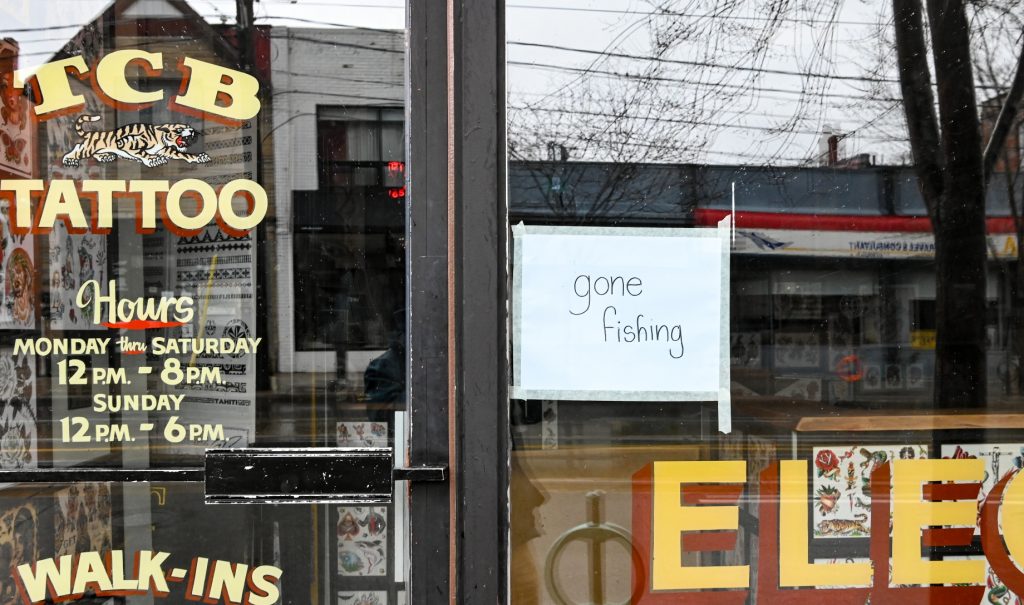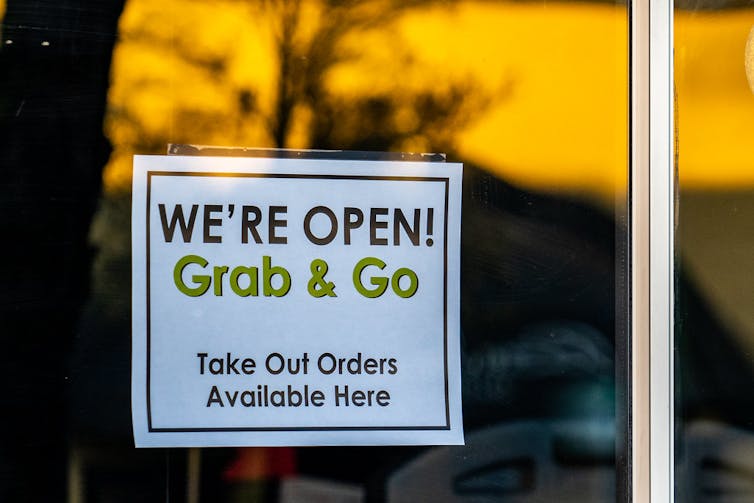Businesses step up to make the products we need to get through the coronavirus pandemic

A tattoo parlour in Toronto remains closed during the COVID-19 pandemic. (michael_swan/flickr), CC BY-SA
BY Brent McKnight and Martina Linnenluecke
March 31, 2020
Brent McKnight is an associate professor in the DeGroote School of Business at McMaster University and Martina Linnenluecke is a professor and the director of the Centre for Corporate Sustainability and Environmental Finance at Macquarie University. This article is republished from The Conversation under a Creative Commons license. Read the original article.
The global coronavirus pandemic is causing unprecedented disruption around the world. Efforts to contain the virus have shut down or hampered many businesses. Across the world, business owners, operators and employees face job losses and imminent economic impacts.
We are a team of researchers who study resilience among businesses and communities. Resilience refers to the ability of individuals, businesses and communities to recover from substantial hardship. Businesses play a critical role in restoring the resilience of communities by providing economic growth, employment and essential goods and services.

Our intention here is to bring a glimmer of hope to those who find the current situation frightening. We highlight some of the incredible creativity, ingenuity and resilience that we see around the globe. Businesses are finding ways to continue operating while supporting the fight against the pandemic. This provides hope for recovery but also points to the potential for more permanent change as we emerge from the current crisis.
Different times
The current coronavirus pandemic differs markedly from the types of disasters that businesses and communities have historically experienced.
More common disasters such as hurricanes, floods or wildfires strike fast and hard in a tight geographic area. These disruptions are short-lived and geographically limited. Our research shows that businesses contribute to community resilience in the aftermath of these disasters. They help to rebuild, make donations, maintain their business operations and deliver critical products and services.
The current crisis disrupts the ability of many individuals and businesses to physically connect. Particularly challenging is that the length of the disruption is highly uncertain and without an immediate resolution. But we are noticing that these same characteristics are also driving firms to rise up to meet this challenge.
Remarkable responses
Businesses are adapting their delivery models to limit physical contact with customers. Restaurants are shifting to take-away and drive-thru options. Grocery stores are emphasizing home delivery. Other businesses — including veterinary clinics — are using curbside drop-offs and pick-ups, bringing medicines and food to customers waiting in cars.
Arts and crafts schools are offering at-home kits. Crock A Doodle, a do-it-yourself pottery painting business, is providing pottery painting kits for home, and 4Cats, an art school franchise, is giving online art lessons.
Gyms and fitness studios are broadcasting online classes. In the United Kingdom, pubs are hosting virtual rooms and moving trivia online.
Flexible arrangements
Companies are responding, and central to this flexibility is the capacity to enable work from home. Businesses without the capability to enable a remote workforce are scrambling to find solutions that permit their firms to continue operating.
Other firms that must remain open and on-site are altering their physical or customer environments. Loblaws and other grocers created special shopping hours for more vulnerable customers and installed plexiglass shields at their stores.
Many manufacturing firms are stepping up to shift their outputs to products required in the new pandemic environment. In Italy, a firm used 3D printers to replace broken respirator valves. In Canada and the United States, automotive suppliers are collaborating to produce ventilators; so are vacuum manufacturers in the U.K.
Distilleries are producing hand sanitizers. Even small firms like Hedley & Bennett, which manufactures aprons and chef gear, have collaborated with a doctor to design and start producing face masks.
In what may become a future norm, conferences are looking to virtual platforms to continue important network events. One such conference, organized by the Group for Research on Organizations and the Natural Environment (GRONEN), is using the crisis to lead with technology solutions to create a virtual conference.
Future conditions
The pandemic is likely to drive changes in the way business is conducted when the current pandemic is contained. After the crisis has passed, we expect that businesses may return to a new normal.
Remote arrangements: We expect more businesses will restructure their work in keeping with changes made during the crisis. Such a move could have a big impact on commuting, congestion and quality of life. Conferences that bring together thousands of people in close physical proximity may give way to smaller gatherings.
GRONEN’s 2020 conference — which is focused on sustainability in the digital age — experiments with new virtual participation strategies. These options might complement the expensive and polluting practice of physical conferences.
Local supply chains: Creating more local supply chains is likely to be a focus of a post-pandemic world. Local supply chains are often dependent on global supply chains across a number of industries.
For instance, in the pharmaceutical industry, the supply of active pharmaceutical ingredients, known as APIs, is dominated by manufacturing facilities in India that process ingredients provided by China. North America is highly reliant on these foreign sources for up to 80 per cent of its APIs.
The situation is similar for ventilators in Canada, with manufacturing firms around the world focused on supplying domestic demand. If the crisis was contained to a single or handful of countries, this problem could be resolved quickly. However, with requests coming from all over the globe, meeting demand is a challenging task.
(Technology company Dyson — known for vacuum cleaners and air purifiers — announced plans to switch to manufacturing much-needed ventilators for COVID-19 health-care efforts.)
Diversified manufacturing: Firms may find that small diversification moves can help them weather storms like this one. Canada’s Linamar, a manufacturer of automobile parts, recently announced plans to begin manufacturing for the medical industry through a strategic manufacturing agreement with Synaptive Medical. Agreements like these can help firms maintain a diversified manufacturing base.
Focus on critical services: Twenty-six countries, including India, are imposing export controls on crucial medical supplies to ensure their own citizens have the materials required. When global and local demand vastly outstrips supply capacity in the short term, expect responsible governments to make these kind of choices. Canada is in a disadvantaged position. Estimates in the United States suggest that 80 per cent of generic drug sales are imported and IbisWorld reports show that Canada imports a majority of its domestic pharmaceutical demand.
Fundamental changes
The coronavirus pandemic has revealed the importance of health care, medical supplies, pharmaceuticals and medical research, and also telecommunication, food supplies and the efficient provision of basic necessities. We are likely to see a greater focus on these sectors and on the critical infrastructure required to provide them.
Prior to the onset of the coronavirus pandemic, the thought that some event could force such a dramatic altering of our society and economy would have been unthinkable. Now, with the world in lockdown, everyone has a shared responsibility to imagine how to build a stronger, more resilient community on the other side. What is your organization’s role?![]()
Brent McKnight is an associate professor in the DeGroote School of Business at McMaster University and Martina Linnenluecke is a professor and the director of the Centre for Corporate Sustainability and Environmental Finance at Macquarie University.
This article is republished from The Conversation under a Creative Commons license. Read the original article.


